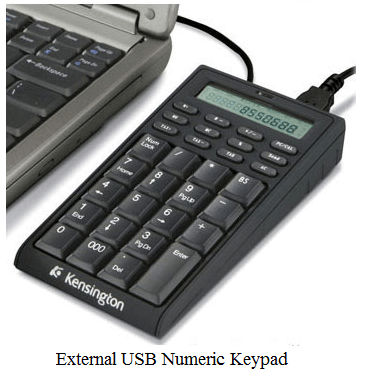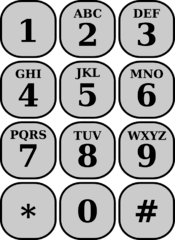What is keypad?
A keypad is a set of buttons or keys arranged on a pad that bear digits, symbols, or alphabetical letters, which can be used as an efficient input device. A keypad may be purely numeric that is found on most computer keyboards, allowing an individual to easily enter numeric values into a computer. It is mainly used for people who have to perform calculations or deals with numbers frequently with a software calculator. Numeric keypads are found on the devices that require mainly numeric input such as vending machines, Point of Sale devices, calculators, digital door locks, push-button telephones, and combination locks. A row of number keys is located on the upper side of a computer keyboard, including a separate numerical pad on the right side used for efficient data entry. Phone keypads are typically alphanumeric, also provide an easier way of remembering phone numbers. It allows the user to enter text messages and names. Additionally, keypads are not available with all computer keyboards, such as laptops and notebooks, so an external plug-in keypad may be purchased separately for compact computers. 
Key layout of the keypadThe first key activated many cash registers, and mechanical calculators used parallel keys with a column of 0 to 9 every location the machine could use. On the Standard Adding Machine, a small keypad started in 1901. The calculator contained the number of keys that were arranged in one row with 0 and 9, where zero on the left, and 9 on the right side. In 1911, with Sundstrand Adding Machine, the modern four-row arrangement debuted. On the keypad of a calculator, there is no standard for the design of the decimal point, four arithmetic operations (like, plus, minus, multiplication, and divide), equal sign (=), or other advanced mathematical operations. John E. Karlin, an industrial psychologist, invented the push-button telephone keypad at Bell Labs in Murray Hill NJ. The numbers 1 to 9 are arranged from left to right, top to bottom with zero in a row under 789, and in the center, on the telephone keypad. Also, telephone keypads include specific buttons such as a star (*) and # (hash, or number sign, or hex, octothorpe, or pound) on either side of 0 key. On a telephone, the key may also bear letters that can be used for various functions, like whole telephone numbers or remembering area codes. Uses and functions of the keypadA computer keyboard has other number keys on the top, and it also includes a small numeric keypad on the side that has buttons similar to the calculator-layout arrangement. This numeric keypad allows a more efficient entry of numerical data. A numeric keypad is mainly located on the right side of the keyboard that helps to perform efficient entry, as most people are right-handed. Keypads appear on many devices, including vending machines, ATM, time clocks, Point of Sale payment devices, digital door locks, and combination locks as they are used for the entry of PINs and for product selection. Origin of the order differenceAlthough telephone keypads are followed by calculator keypads for almost thirty years. John Karlin led a Bell Labs Human Factors group that gave the telephone layout the top-to-bottom order. They tried out various kinds of layout such as Facit like the two-row arrangement, rows of three buttons, buttons in an arc, and buttons in a circle. The adopted layout was the best layout, which was the conclusion of the study of Human Factor Engineering. According to the conclusions, there are numerous folk histories and popular theories that describe the inverse order of the calculator and telephone keypads.
Telephone keypad
A telephone keypad is installed on a push-button telephone for dialing a telephone number. In the 1960s, when the DTMF (dual-tone multi-frequency) signaling system was developed in the Bell System in the United States, the telephone keypad was standardized. The rotary dialing was developed in electromechanical switching systems that were replaced by a dual-tone multi-frequency system. In the 1990s, most of the telephone keypads were also designed in order to produce loop-disconnect pulses electronically due to the widely used of the rotary dial equipment. Also, some keypads were switched to produce pulse or DTMF. In the 1950s, under the directorship of John Karlin at the Human Factors Engineering Department of Bell Labs, Richard Deininger developed the modern telephone keypad. The contemporary keypad is designed with 12 push buttons that are arranged as four rows and three columns of keys in a rectangular array. The keypads omitted the lower left and lower right keys for civilian subscriber service that commonly are assigned to the star (*) and number sign (#) signals, between 1963 and 1968. These keys were included to offer signals in business applications for anticipated data entry purposes but found appropriate use in Custom Calling Services features. Layout of telephone keypadThe design of the digit keys is different from the numeric and calculator keypads. There were different human factors testing at Bell Labs to choose this layout. Late in the 1950s, mechanical calculators were not more popular due to not widely used, and only a few people had experience with them. Timely, the calculator only began to settle on a common layout. After a 1960 paper, the layout was found that is common to use in today's calculator. In any case, it was ensured by the result of Bell Labs testing; the telephone design that has 1, 2, and 3 keys in the top row was a little faster as compared to the calculator that has 1, 2, and 3 keys in the bottom row. Most keys also contain letters on the basis of the following system:
These letters have been used for many functions, including the leading letters of telephone exchange names. Telephone numbers had seven digits, including a two-digit prefix before the switch to All-Number Calling in the mid-20th century, the United States, which was expressed in letters instead of digits, such as KL6-6556. A similar two-letter code was used by the UK numbering system for a region to form the first part of the subscriber trunk dialing. The letters have also been used in the United States in terms of a technique for remembering telephone numbers easily. For example, a painter might license telephone number 1-800-845-8765, but it can be an easier and more memorable phone word 1-800-PAINTER by advertise. Sometimes many businesses publicize a number that can have more letters as compared to digits in the phone number. Commonly, it means that if a caller dials any number, he just stops dialing at 7 digits after the area code. Also, the extra digits are ignored by the central office after 7 digits (Area code). The letters are used for text entry tasks in mobile phones, such as type anything in search bar to browse in the web, entering names in the phone book, and text messaging. Phones used later predictive text processing and multi-tap to speed up the process to compensate for the smaller number of keys. This method has been outdated by touch-screen phones because they have the ability to pretend as many buttons as necessary for full-text entry. Letter mappingIn the telephone history, keypad layouts and the positions of telephone dials have been associated with several patterns of mapping characters and letters to numbers. The system used in Denmark and the U.K were different from each other, and the system used in the U.K. was different from Australia and the U.S. In the 1960s, when direct international dialing was introduced, the use of alphanumeric codes for exchanges was abandoned in Europe. Because if the user dials a number VIC 8900 on a Danish telephone, and if dials this number on a British telephone, its result will be a different number. Therefore, at that time, letters were no included on the dials of new telephones. Until the introduction of mobile phones, letters did not re-appear on phones in Europe, and the new international standard ITU E.161/ISO 9995-8 was followed by the layout. In the mid-1990s, an international standard (ITU E.161) was established by the ITU that the layout could be used for new devices. The ETSI ES 202 130 is a standard that was published by the independent ETSI organization in 2003 and updated in 2007, which deals with all languages used in Europe. Instead of traditional telephone keypads, many newer smartphones like BlackBerry and Palm Treo have full alphanumeric keyboards. To dial a number containing convenience letters, the user must execute additional steps. Followed by the desired letter user can press the Alt key On certain BlackBerry device.
Next TopicWhat is the hub
|
 For Videos Join Our Youtube Channel: Join Now
For Videos Join Our Youtube Channel: Join Now
Feedback
- Send your Feedback to [email protected]
Help Others, Please Share










